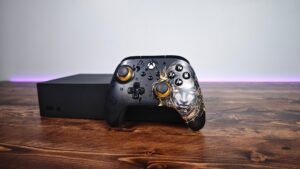Head-mounted displays (HMDs) have long been a staple for seeing pictures in AR and VR.
Self-contained units blend most of its hardware internally, meaning it takes a hefty amount of software to push images. Campfire is a new AR system which adds a few more devices into a setup, but improves the quality of holograms. This is done via a self-powered console that projects AR holograms with less latency and an add-on controller for smartphones to handle the images with tools.
In its early release, Campfire is directly inspired by a group of users collaborating and communicating around a center. The console acts as the Campfire itself while users are gathered around with headsets. Its result brings users closer to AR as a practical tool for industries including manufacturing, architecture and CAD design.

Starting with the headset, it works similar to Microsoft’s HoloLens and other AR HMDs by using the real world as a place to project images. It also shares some VR uses, with the company suggesting it can also simulate environments if needed. The weight of the headset is also distributed to the front and rear with a halo-style headband with rounded pads on the skull and forehead. Unlike shorter gaming sessions, this gives work teams added comfort for extended meetings and presentations that use AR models.
The tech also uses a few tricks from VR gaming to make AR work for daily business. The AR images are projected as 3D models, while users are studying them like players viewing characters in game galleries. In the case of work, this is where a central cross-shaped console projects models in all types of sizes. Users and presenters can also control the AR objects with their phones with the add-on pack. A few tools let users manipulate the size of objects and even zoom into layers (i.e. entering an AR human body or going into a 3D building to show internals).
This veers away from traditional hand controllers, which use a combination of finger pinching and buttons with a slight learning curve. But the Campfire controls go back to basics with an app which features different modes for editing and manipulation. Even without a team, staff and users can use Campfire alone with a single player-type format.

According to CEO Jay Wright, the AR tech was made with 60 different patents. For its design, the project was picked up by frog, who specialize in overall aesthetics and shapes of products and apps (i.e. Pfizer, UNICEF). The collaboration also helped with creating the software, which lets users bring the entire AR presentation over to video calls and remote meetings by turning it into a livestream.
“The vision for holographic collaboration has been talked about for decades, but not realized in products with any measure of success,” Wright said, adding Campfire hopes to nail a proper formula for using AR at work. “By focusing on specific needs for design and engineering, we’ve reimagined the entire stack to deliver an experience that takes a giant step toward the vision-and more importantly enables a giant step in productivity.”

Campfire isn’t currently in the market, while the project has raised over $8 million in seed funding and will be commercially available in Fall 2021.




